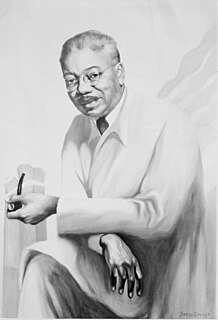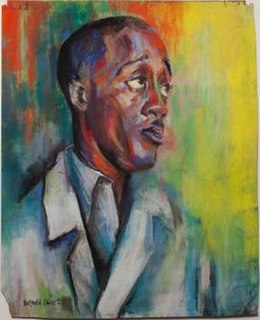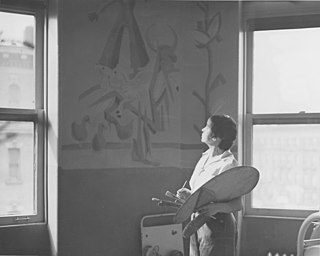Related Research Articles

Charles Henry Alston was an American painter, sculptor, illustrator, muralist and teacher who lived and worked in the New York City neighborhood of Harlem. Alston was active in the Harlem Renaissance; Alston was the first African-American supervisor for the Works Progress Administration's Federal Art Project. Alston designed and painted murals at the Harlem Hospital and the Golden State Mutual Life Insurance Building. In 1990 Alston's bust of Martin Luther King, Jr. became the first image of an African American displayed at the White House.

Jacob Lawrence was an American painter known for his portrayal of African-American life. As well as a painter, storyteller, and interpreter, he was an educator. Lawrence referred to his style as "dynamic cubism", though by his own account the primary influence was not so much French art as the shapes and colors of Harlem. He brought the African-American experience to life using blacks and browns juxtaposed with vivid colors. He also taught and spent 16 years as a professor at the University of Washington.

Romare Bearden was an American artist, author, and songwriter. He worked with many types of media including cartoons, oils, and collages. Born in Charlotte, North Carolina, Bearden grew up in New York City and Pittsburgh, Pennsylvania, and graduated from New York University in 1935.

Aaron Douglas was an American painter, illustrator and visual arts educator. He was a major figure in the Harlem Renaissance. He developed his art career painting murals and creating illustrations that addressed social issues around race and segregation in the United States by utilizing African-centric imagery. Douglas set the stage for young, African-American artists to enter public arts realm through his involvement with the Harlem Artists Guild. In 1944, he concluded his art career by founding the Art Department at Fisk University in Nashville, Tennessee. He taught visual art classes at Fisk until his retirement in 1966. Douglas is known as a prominent leader in modern African-American art whose work influenced artists for years to come.
African-American art is a broad term describing the visual arts of the American black community. Influenced by various cultural traditions, including those of Africa, Europe and the Americas, traditional African-American art forms include the range of plastic arts, from basket weaving, pottery, and quilting to woodcarving and painting.

The Studio Museum in Harlem is an American art museum devoted to the work of artists of African descent. The Museum’s galleries are currently closed in preparation for a building project that will replace the current building, located at 144 West 125th Street between Adam Clayton Powell Jr. Boulevard and Lenox Avenue in Harlem, Manhattan, New York City, with a new one on the same site. Founded in 1968, the museum collects, preserves and interprets art created by African Americans, members of the African diaspora, and artists from the African continent. Its scope includes exhibitions, artists-in-residence programs, educational and public programming, and a permanent collection.

Hale Aspacio Woodruff was an American artist known for his murals, paintings, and prints.

Augusta Savage was an American sculptor associated with the Harlem Renaissance. She was also a teacher whose studio was important to the careers of a generation of artists who would become nationally known. She worked for equal rights for African Americans in the arts.

Henry Wilmer "Mike" Bannarn was an African-American artist, best known for his work during the Harlem Renaissance period. He is known for his work in sculpture and as a character artist in the various paint mediums, Conté crayon, pastel, and free-form sketch.

Norman Wilfred Lewis was an American painter, scholar, and teacher. Lewis, who was African-American and of Bermudian descent, was associated with abstract expressionism, and used representational strategies to focus on black urban life and his community's struggles.
Emma Amos is a postmodernist African-American painter and printmaker.
Merton Daniel Simpson was an American abstract expressionist painter and African and tribal art collector and dealer.
Betty Blayton-Taylor was an American activist, advocate, artist, arts administrator and educator, and lecturer. As an artist, Blanton-Taylor was an illustrator, painter, printmaker, and sculptor. She is best known for her works often described as "spiritual abstractions". Blayton was a founding member of the Studio Museum in Harlem and board secretary., co-founder and executive director of Harlem Children's Art Carnival (CAC), and a co-founder of Harlem Textile Works. She was also an advisor, consultant and board member to a variety of other arts and community-based service organizations and programs. Her abstract methods created a space for the viewer to insert themselves into the piece, allowing for self reflection, a central aspect of Blayton-Taylor’s work.

Spiral was a collective of African-American artists initially formed by Romare Bearden, Charles Alston, Norman Lewis, and Hale Woodruff on July 5, 1963. It has since become the name of an exhibition, Spiral: Perspectives on an African-American Art Collective.
A number of theatre companies are associated with the Harlem Renaissance.

The Harlem Community Art Center was a Federal Art Project community art center that operated from 1937 to 1942. It influenced various budding artists intent on depicting Harlem and led to the formation of the Harlem Arts Alliance. It became a countrywide exemplar for others, notably the South Side Community Art Center in Chicago.

Elba Lightfoot was an African-American artist known for her work on the WPA murals at Harlem Hospital.
"Where We At" Black Women Artists, Inc. (WWA) was a collective of black women artists affiliated with the Black Arts Movement of the 1960s and 1970s. It included artists such as Dindga McCannon, Kay Brown, Faith Ringgold, Carol Blank, Jerri Crooks, Charlotte Kâ (Richardson), and Gylbert Coker. Gylbert Coker started an art column in the African American Newspaper, The Amsterdam News, to present and discuss African American art exhibitions, art work, and artists. In 1969 she became the second black person to work in the art department of the Guggenheim Museum. The first black person was Kynaston McShine, and following Coker was Cheryl McClenney. In 1970 Coker joined the registration department at the Museum of Modern Art. In 1972 she became the first Chief Curator at the Studio Museum in Harlem where she produced a number of important exhibitions, among them The Bob Thompson Exhibition in 1976 and the Hale Woodruff 50 Years of Art Exhibition in 1978. During the development of the Woodruff exhibition she discovered the WPA murals Woodruff and Charles Alston produced inside Harlem Hospital. Her discovery and initiation to gain recognition for the art work helped to save and conserve these murals. She developed a registration and cataloging system for the SMH collection. She went on to catalog the Palmer Hayden Collection, The Charles Alston Collection, and served as the private secretary to his widow Ida Mae Cullen. One of her largest exhibition projects was the 1980 and 1982 outdoor exhibition, Art Across The Park which she produced with David Hammons and Horace Brockington. Where We At was formed in the spring of 1971, in the wake of an exhibition of the same name organized by 14 black women artists at the Acts of Art Gallery in Greenwich Village. Themes such as the unity of the Black family, Black male-female relationships, contemporary social conditions, and African traditions were central to the work of the WWA artists. The group was intended to serve as a source of empowerment for African-American women, providing a means for them to control their self-representation and to explore issues of Black women’s sensibility and aesthetics. Like AfriCobra, a Chicago-based Black Arts group, the WWA was active in fostering art within the African-American community and using it as a tool of awareness and liberation. The group organized workshops in schools, hospitals, and cultural centers, as well as art classes for youth in their communities.
The Harlem Artists Guild (1935–41) was an African-American organization founded by artists including Augusta Savage, Charles Alston, Elba Lightfoot and bibliophile Arthur Schomburg with the aims of encouraging young talent, providing a forum for the discussion of the visual arts in the community, fostering understanding between artists and the public through education towards an appreciation of art, focusing on issues of general concern to Black artists such as racism, poverty and unemployment, and cooperating with agencies to improve conditions and raise standards of living and achievement among African-American artists. It is said to have had its origins in the dissatisfaction of African-American artists with the activities of the Harmon Foundation, and was described by co-founder Alston as "a pressure group to get more black artists on the federal projects."
References
- ↑ "Alston, Charles". Benezit Dictionary of Artists. Oxford Art Online. Oxford University Press. Retrieved 3 February 2017.
- 1 2 "Harlem: Art and the Community". northbysouth.kenyon.edu. Retrieved 2017-01-28.
- ↑ "ARTSEDGE: Drop Me Off in Harlem". artsedge.kennedy-center.org. Retrieved 2017-01-28.
- ↑ "Norman Lewis, an influential painter". African American Registry (AAREG). Retrieved 2020-05-09.
| This article about a United States arts organization is a stub. You can help Wikipedia by expanding it. |